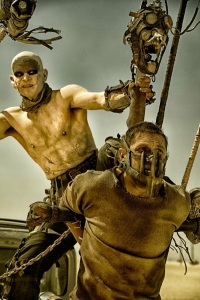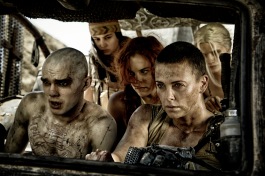
In a dystopian future society where the rich live luxuriously in ‘The Capitol’ and the poor are divided into exclusive districts and forced to live feudally, 24 children are chosen at random every year and let loose in an enclosed arena where they are cajoled into mortal combat until only one remains. Based on a novel for young adults written by Suzanne Collins, The Hunger Games follows sixteen-year-old Katniss Everdeen who is selected to compete in the 74th of these annual televised contests.
By far the most gratifying thing about this film doing so well at the box office is the sheer number of people that are coming into contact with a narrative that throws light on the ugly side of current social phenomena and illustrates clearly and simply how hegemony works.
Like the best dystopias, Panem – where The Hunger Games is set – has carefully designed hierarchical structures which are maintained with a delicate balancing act. Demonstrating the clockwork involved in the working of a fictional society and having an emotional character-based drama unfolding at the same time is the author’s own balancing act. In fact, as long as neither overpowers the other, each inextricably boosts the effect of the other. For example, we can’t be moved to concern by Katniss’ plight if we don’t know how trammelled by violent controlling measures she and her fellow poverty-stricken district-dwellers are. Equally, we can’t be expected to get our head around the intricate details of Panem unless we see how its system shapes the life of a human being living at its centre.
The targets of Collins’ barbed satire are entwined in a tight cluster which probably contains as many of the viewers’ interpretations as the author’s own intentions. Those that seem most clear however revolve around reality TV, particularly reality TV as a means of spellbinding large swathes of populations into becoming obsessed with false narratives and a false hope of escaping a life of drudgery, thereby ironically easing the pressure of a life of drudgery, leading to an extension of the drudge itself. Also explored is the widespread cultural sentimentality that results from said false narratives, and how it begins to seep into real life.
The desensitising effect that this sick-sweet sentimentality leads to is of particular importance to The Hunger Games, specifically an indifference to violence, ‘The Games’ itself being a competition in which children kill each other.
 The viewers of the contest are the wealthy minority who live within the capitol and bet with glee on the eventual winner. The costume design and palette of The Capitol’s citizens contribute magnificently to the idea of ‘the spectacle’ (ps. Read this if you want, yes, all of it) that encompasses their lives. Their lurid face paint and extravagant dress is ridiculous and terrifying in equal measure; the same could be said for their exploitation of children, with the emphasis on the terrifying.
The viewers of the contest are the wealthy minority who live within the capitol and bet with glee on the eventual winner. The costume design and palette of The Capitol’s citizens contribute magnificently to the idea of ‘the spectacle’ (ps. Read this if you want, yes, all of it) that encompasses their lives. Their lurid face paint and extravagant dress is ridiculous and terrifying in equal measure; the same could be said for their exploitation of children, with the emphasis on the terrifying.
All of this probably applies to the novel too, I wouldn’t know, haven’t read it, will now. My point is, the narrative is solid and, as Collins herself co-wrote the screenplay, the film tells her story well. With the most important thing taken care of, the only hurdles that could possibly hinder its success are exclusively down to the makers’ cinematic skill – how it is shot, how it is acted, how it is paced, how it is scored.
And most importantly: how it is edited. Because thankfully, everything else works nicely – particularly the acting (Jennifer Lawrence does a very good job). It is the editing that lets it down in my opinion – and I’d rather call it censorship. That is because, for a film that relies on a brutal and violent situation to engage and appal us, The Hunger Games is remarkably devoid of violence. In fact I don’t recall seeing a single drop of blood from start to finish. Was this a clever self-referential comment on the theme? Were we intentionally shielded from gore to stop us reacting in a human way, so that maybe we might see how anesthetised we already are to violence? To warn us how close we are to becoming like The Capitol’s citizens ourselves?
Well apparently not. Because while the version shown in British cinemas is fairly anodyne, this was not always the case. The original cut of the film submitted for classification was given a ‘15’ rating. Eager for it to be able to reach as large an audience as possible, the studio asked for advice from the BBFC on what changes could be made to downgrade it to a ‘12a’ rating. This included shortening the length of some particularly violent shots and digitally removing blood splashes from wounds and weapons.
So this is not the typical censorship we hear about where a single-minded director has their vision undermined by a country’s film board snipping out the bits it considers too nasty for its citizens. This is the makers and distributors of a film actively self-censoring their own work for marketing purposes.
But is there a less cynical motivation behind the cut? The original novel has been demonstrably popular with older children/young teens, with many of its readers falling between the ages of 11 and 14. It could be argued then that the self-censorship isn’t money-grubbing but actually makes the film available for the audience that enjoyed the book.

I suppose that makes some sense but the problem for me was that I wanted the shock and horror to really hit home. I wanted the promise of the little chill that ran through me when I first heard the film’s synopsis to be fully delivered. And the fact that a more brutal version exists and is shown in other countries is a bit of a let down.
Of course I understand the idea that cutting away before actual physical savagery can be more psychologically terrifying than not doing so. Memorably, the oft-referenced Psycho shower scene has plenty of shots showing the fatal knife thrusts but none of actual contact with the victim’s skin. I just don’t think such an approach works for The Hunger Games and it isn’t supposed to either, as the existence of the original cut testifies to. When the most important things about a social satire are child cruelty and a failure to react negatively to child cruelty, it seems obvious that we need to be given a chance to abhor such a numb society by seeing clearly on our silver screens what The Capitol’s citizens see on their TV screens. I would argue that the young teenagers who can handle the book won’t be too traumatised by a more explicit film. So why not keep the blood and let the 12-year-olds sneak in, as they always do anyway? Either that or have showings of the uncut version late at night.
All of this is just a small detraction from what is essentially a good film, especially as it updates the dystopia genre for the digital age and might well lead new people to works such as Brazil or Nineteen Eighty-Four. Every generation needs to be served a lucid vision of a society it is at risk of sleepwalking into and, for 2012, The Hunger Games will do nicely enough.
 The idea of a relentless thrust through 2 hours of near-silent cinema with laconic characters who let the cars do the snarling is an enticing one, one that sets its own challenge. How can a film maintain its momentum when every scene is an explosive set piece, stacked-up against the last and precision-engineered to top whatever came before? The fuel needs to be pure and Mad Max: Fury Road certainly draws its own world with a set of bold visual ideas followed through to their absurd conclusions. It’s a great starting point.
The idea of a relentless thrust through 2 hours of near-silent cinema with laconic characters who let the cars do the snarling is an enticing one, one that sets its own challenge. How can a film maintain its momentum when every scene is an explosive set piece, stacked-up against the last and precision-engineered to top whatever came before? The fuel needs to be pure and Mad Max: Fury Road certainly draws its own world with a set of bold visual ideas followed through to their absurd conclusions. It’s a great starting point. The more I think about it, the more I realise that I liked the film despite sometimes feeling on the wrong end of one of its blood transfusions. Everything about its design is immaculately cohesive, from the ridiculous teal/orange colour grading to the grinding gears and grinning martyrs that populate its fiery dust storms. It is a singular vision and gloriously female-led at times. The only problem, on the first viewing, is pacing. 2 hours 10 minutes of this stuff is too exhausting – it mars the final half hour of the film, which in any case is a kind of journey home that should have begun at its midpoint anyway. The editing of the action is expertly done, but add a little more punctuation here and there and we’re laughing (maniacally into the void). ((With silver spray-painted mouths.))
The more I think about it, the more I realise that I liked the film despite sometimes feeling on the wrong end of one of its blood transfusions. Everything about its design is immaculately cohesive, from the ridiculous teal/orange colour grading to the grinding gears and grinning martyrs that populate its fiery dust storms. It is a singular vision and gloriously female-led at times. The only problem, on the first viewing, is pacing. 2 hours 10 minutes of this stuff is too exhausting – it mars the final half hour of the film, which in any case is a kind of journey home that should have begun at its midpoint anyway. The editing of the action is expertly done, but add a little more punctuation here and there and we’re laughing (maniacally into the void). ((With silver spray-painted mouths.))

 The viewers of the contest are the wealthy minority who live within the capitol and bet with glee on the eventual winner. The costume design and palette of The Capitol’s citizens contribute magnificently to the idea of ‘the spectacle’ (ps. Read
The viewers of the contest are the wealthy minority who live within the capitol and bet with glee on the eventual winner. The costume design and palette of The Capitol’s citizens contribute magnificently to the idea of ‘the spectacle’ (ps. Read 